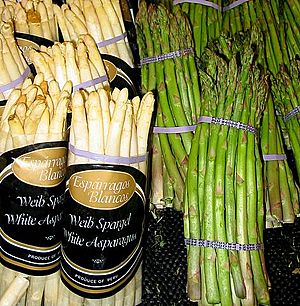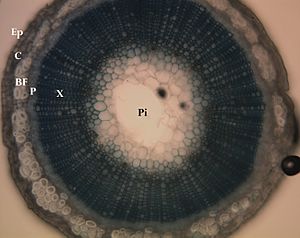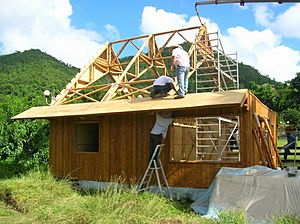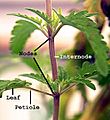Plant stem facts for kids

A stem is a main part of a vascular plant. Think of it like the plant's body! Stems usually have special spots called nodes. These nodes are where leaves, flowers, or other stems grow from. The other main part of a plant is its roots, which are usually underground. While most stems grow above the soil, some plants have stems that grow underground. These are called stolons or rhizomes.
Contents
What Stems Do
Stems are super important for plants! They have four main jobs:
- Support: Stems hold up the leaves, flowers, and fruits. They help the leaves reach sunlight, which is vital for the plant to make its own food.
- Transport: Stems act like pipelines. They move water and nutrients from the roots to the rest of the plant. They also move sugars made in the leaves to other parts. This happens through special tubes called xylem and phloem.
- Storage: Some stems can store nutrients for the plant, like a pantry.
- Making New Tissue: Stems have special growing areas called meristems. These areas contain cells that are always dividing. This helps the plant grow new leaves, stems, and roots.
Most plant cells live for about one to three years. However, in big plants like trees, much of the older tissue, like bark and some wood, is actually made of cells that are no longer living.
Different Kinds of Stems
Stems can look very different depending on what they need to do. Some are specialized for storing food, helping the plant reproduce, protecting it, or even making food through photosynthesis. Here are a few examples:
- Bulbs: These are short, underground stems with thick, fleshy leaves attached. Think of an onion, daffodil, or tulip. Bulbs often help the plant make new plants by splitting or growing small new bulblets.
- Tree Trunks: A tree trunk is a very strong, woody stem. It's usually taller than 5 meters and is the main support for the whole tree.
- Thorns: These are like tiny, sharp, pointed stems. They help protect the plant from animals that might want to eat it. An example is the hawthorn tree.
Inside a Stem
The most important parts inside a stem are the vascular tissues. These tissues are like the plant's circulatory system. They play a huge role in moving water and nutrients all around the plant.
- Xylem: This tissue has many hollow tubes that carry water and minerals from the roots up to the leaves.
- Phloem: This tissue contains living cells that carry sugars (food) made in the leaves to other parts of the plant where it's needed for growth or storage.
Why Stems are Important to Us
Stems are incredibly useful to people! We use them in many ways, from food to building materials and even medicines.
Stems as Food
Many stems are delicious and nutritious!
- Some major food crops, like potatoes and taro, are actually underground stems.
- Sugar cane stems are a main source of sugar.
- We get maple sugar from the trunks of maple trees.
- Other vegetables that are stems include asparagus, bamboo shoots, cactus pads, kohlrabi, and water chestnuts.
- The spice cinnamon comes from the bark of a tree trunk.
- Even things like Gum arabic, used in many foods, come from tree trunks. Chicle, the main ingredient in chewing gum, also comes from tree trunks.
Stems for Medicine
Some important medicines come from plant stems:
- Quinine, used to treat malaria, comes from the bark of cinchona trees.
- Camphor is distilled from the wood of a tree related to cinnamon.
- The muscle relaxant curare comes from the bark of tropical vines.
Stems for Building and Materials
Wood, which is the stem of trees, is used in thousands of ways.
- It's a common material for buildings, furniture, and boats.
- Wood is also used to make musical instruments, sports equipment, and even toys.
- Wood pulp from tree trunks is widely used to make paper, cardboard, and even some plastics and textiles like rayon.
- Bamboo stems are also incredibly versatile. They are used for paper, buildings, furniture, boats, and even fishing poles.
- Trunks of palm trees and tree ferns are often used for building in some areas.
- Reed stems are important building materials too.
Other useful materials from stems include:
- Tannins, used for tanning leather, come from the wood of certain trees.
- Cork, used for bottle stoppers and other products, comes from the bark of the cork oak tree.
- Rubber comes from the trunks of the Hevea brasiliensis tree.
- Rattan, used for furniture and baskets, is made from the stems of tropical palms.
- Bast fibers like flax, hemp, jute, and ramie are used for textiles and rope.
- The very first paper was made from the stems of papyrus by the ancient Egyptians.
Other Uses of Stems
- Amber is fossilized sap from tree trunks. It's used for jewelry and can sometimes contain ancient insects or plants!
- Resins from conifer wood are used to make turpentine and rosin.
- Tree bark is often used as a mulch in gardens to help plants grow.
Beautiful Stems
Some plants are grown just because their stems look so cool!
- The white bark of the paper birch tree is very striking.
- The twisted branches of corkscrew willow and Harry Lauder's walking stick are unique.
- The red, peeling bark of the paperbark maple is also very attractive.
Images for kids
-
Decumbent stem in Cucurbita maxima.
-
Stems of two Roystonea regia palms showing characteristic bulge, leaf scars and fibrous roots, Kolkata, India
-
The trunk of this redwood tree is its stem.
See also
 In Spanish: Tallo para niños
In Spanish: Tallo para niños











